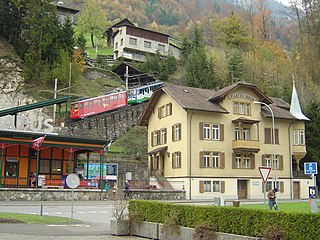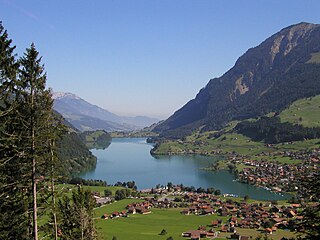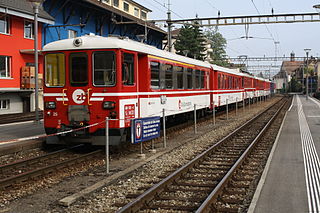
Alpnach is a village in the canton of Obwalden in Switzerland. It comprises the villages of Alpnach Dorf, Alpnachstad and Schoried.

Giswil is a municipality in the canton of Obwalden in Switzerland.

Lungern is a municipality in the canton of Obwalden in Switzerland. It encompasses Lake Lungern and, besides the village of Lungern, the settlements of Bürglen, Kaiserstuhl and Obsee.

Engelberg is a village resort and a municipality in the canton of Obwalden in Switzerland. Alongside the central village of Engelberg, the municipality encompasses additional settlements, including Grafenort, Oberberg and Schwand.

Nidwalden or Nidwald is one of the 26 cantons forming the Swiss Confederation. It is composed of eleven municipalities and the seat of the government and parliament is in Stans. It is traditionally considered a "half-canton", the other half being Obwalden.

Dallenwil is a municipality in the canton of Nidwalden in Switzerland.

Stansstad is a municipality in the canton of Nidwalden in Switzerland.

Wolfenschiessen is a village and municipality in the canton of Nidwalden in Switzerland. Besides the village of Wolfenschiessen itself, the municipality includes the settlements of Altzellen, Büren ob dem Bach, Dörfli, and Oberrickenbach, together with a large area of high alpine land, mountains, lakes, and glaciers.

Meiringen is a municipality in the Interlaken-Oberhasli administrative district in the canton of Bern in Switzerland. Besides the village of Meiringen, the municipality includes the settlements of Balm, Brünigen, Eisenbolgen, Hausen, Prasti, Sand, Stein, Unterbach, Unterheidon, Wylerli and Zaun. The municipal coat of arms shows a black eagle in a yellow field. Formerly the coat of arms of the entire Oberhasli Talschaft, this design continues the imperial coat of arms.

Brienz is a village and municipality on the northern shore of Lake Brienz, at the foot of the Brienzer Rothorn mountain, and in the Bernese Oberland region of Switzerland. Besides the village of Brienz, the municipality includes the settlements of Kienholz and Axalp.

The Brünig railway line is a Swiss narrow gauge railway line that links Lucerne, in central Switzerland, with Interlaken, in the Bernese Oberland. The line runs via Alpnachstad, Giswil, Meiringen and Brienz, and passes over the Brünig Pass, using sections of rack railway to overcome the gradients, but with most of the line operated by normal adhesion methods.

The Zentralbahn is a Swiss railway company that owns and operates two connecting railway lines in Central Switzerland and the Bernese Oberland. It was created on January 1, 2005, with the acquisition of the independently owned Luzern–Stans–Engelberg line, and the Brünig line of the Swiss Federal Railways. The company has its headquarters in Stansstad.

Brienzwiler is a municipality in the Interlaken-Oberhasli administrative district in the canton of Bern in Switzerland. Besides the village of Brienzwiler, the municipality also includes the settlement of Balmhof.

Niederried bei Interlaken is a municipality in the Interlaken-Oberhasli administrative district in the canton of Bern in Switzerland.

Horw is a municipality in the district of Lucerne in the canton of Lucerne in Switzerland.

Hergiswil railway station is a Swiss railway station in the municipality of Hergiswil in the canton of Nidwalden. It is at the junction of the Brünig line, which links Lucerne and Interlaken, and the Luzern–Stans–Engelberg line. Both lines are of metre gauge and owned by the Zentralbahn railway company. To the south of the station the Brünig line enters the Lopper I tunnel to Alpnach whilst the Luzern–Stans–Engelberg line enters the Lopper II tunnel to Stansstad.

Hergiswil Matt railway station is a Swiss railway station in the municipality of Hergiswil in the canton of Nidwalden. It is on the Brünig line of the Zentralbahn railway company, which links Lucerne and Interlaken, and is also used by trains of the Luzern–Stans–Engelberg line.

Kriens Mattenhof railway station is a Swiss railway station in the municipality of Kriens in the canton of Lucerne. It is on the Brünig line of the Zentralbahn railway company, which links Lucerne and Interlaken, and is also used by trains of the Luzern–Stans–Engelberg line.

Luzern Allmend/Messe railway station is a railway station in the city of Lucerne, in the Swiss canton of Lucerne. It is located adjacent to the Swissporarena, in the south of the city. The station is on the Brünig line of the Zentralbahn railway company, and is used by trains of the Luzern–Stans–Engelberg line.

Horw railway station is a Swiss railway station in the municipality of Horw in the canton of Lucerne. It is on the Brünig line of the Zentralbahn railway company, which links Lucerne and Interlaken, and is also used by trains of the Luzern–Stans–Engelberg line.

























